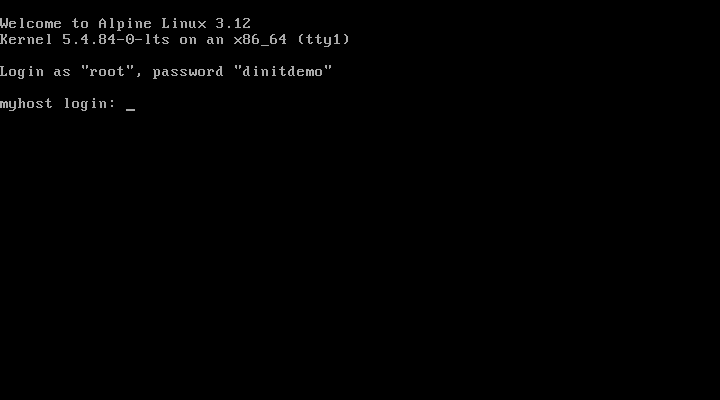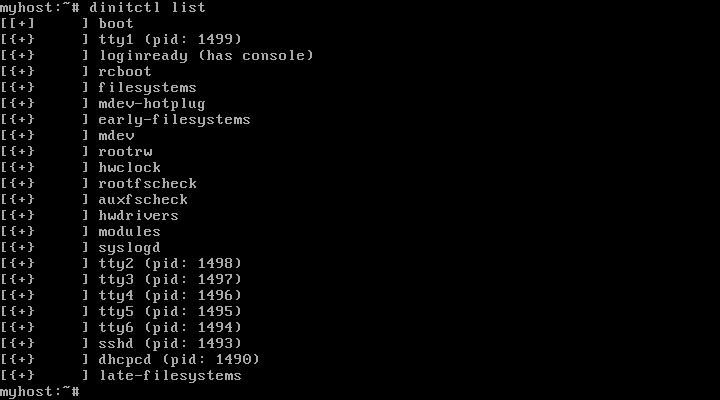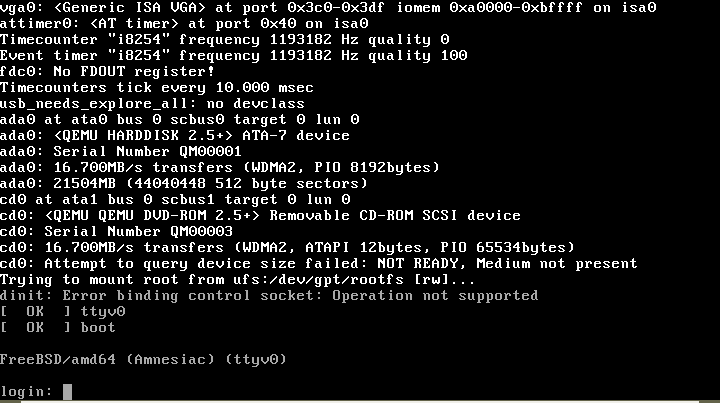Escape From System D, episode VII
21 January 2021, #dinit
Summary: Dinit reaches alpha; Alpine linux demo image; Booting FreeBSD
Well, it’s been an awfully long time since I last blogged about Dinit (web page, github), my service-manager / init / wannabe-Systemd-competitor. I’d have to say, I never thought it would take this long to come this far; when I started the project, it didn’t seem such a major undertaking, but as is often the case with hobby projects, life started getting in the way.
In an earlier episode, I said:
Keeping the momentum up has been difficult, and there’s been some longish periods where I haven’t made any commits. In truth, that’s probably to be expected for a solo, non-funded project, but I’m wary that a month of inactivity can easily become three, then six, and then before you know it you’ve actually stopped working on the project (and probably started on something else). I’m determined not to let that happen – Dinit will be completed. I think the key is to choose the right requirements for “completion” so that it can realistically happen; I’ve laid out some “required for 1.0” items in the TODO file in the repository and intend to implement them, but I do have to restrain myself from adding too much. It’s a balance between producing software that you are fully happy with and that feels complete and polished.
This still holds. On the positive side, I have been chipping away at those TODOs; on the other hand I still occasionally find myself adding more TODOs, so it’s a little hard to measure progress.
But, I released a new version just recently, and I’m finally happy to call Dinit “alpha stage” software. Meaning, in this case, that the core functionality is really complete, but various planned supporting functionality is still missing.
I myself have been running Dinit as the init and primary service manager on my home desktop system for many years now, so I’m reasonably confident that it’s solid. When I do find bugs now, they tend to be minor mistakes in service management functions rather than crashes or hangs. The test suite has become quite extensive and proven very useful in finding regressions early.
Alpine VM image
I decided to try creating a VM image that I could distribute to anyone who wanted to see Dinit in action; this would also serve as an experiment to see if I could create a system based on a distribution that was able to boot via Dinit. I wanted it to be small, and one candidate that immediately came to mind was Alpine linux.
Alpine is a Musl libc based system which normally uses a combination of Busybox‘s init and OpenRC service management (historically, Systemd couldn’t be built against Musl; I don’t know if that’s still the case. Dinit has no issues). Alpine’s very compact, so it fits the bill nicely for a base system to use with Dinit.
After a few tweaks to the example service definitions (included in the Dinit source tree), I was able to boot Alpine, including bring up the network, sshd and terminal login sessions, using Dinit! The resulting image is here, if you’d like to try it yourself.
Login screen presented after booting with Dinit
Running “dinitctl list” command on Alpine
(The main thing I had to deal with was that Alpine uses mdev, rather than udev, for device tree management. This meant adapting the services that start udev, and figuring out to get the kernel modules loaded which were necessary to drive the available hardware – particularly, the ethernet driver! Fortunately I was able to inspect and borrow from the existing Alpine boot scripts).
Booting FreeBSD
A longer-term goal has always been to be able to use Dinit on non-Linux systems, in particular some of the *BSD variants. Flushed with success after booting Alpine, I thought I’d also give BSD a quick try (Dinit has successfully built and run on a number of BSDs for some time, but it hasn’t been usable as the primary init on such systems).
Initially I experimented with OpenBSD, but I quickly gave up (there is no way that I could determine to boot an alternative init using OpenBSD, which meant that I had to continuously revert to a backup image in order to be able to boot again, every time I got a failure; also, I suspect that the init executable on OpenBSD needs to be statically linked). Moving on to FreeBSD, I found it a little easier – I could choose an init at boot time, so it was easy to switch back-and-forth between dinit and the original init.
However, dinit was crashing very quickly, and it took a bit of debugging to discover why. On Linux, init is started with three file descriptors already open and connected to the console – these are stdin (0), stdout (1) and stderr (2). Then, pretty much the first thing that happens when dinit starts is that it opens an epoll set, which becomes the next file descriptor (3); this actually happens during construction of the global “eventloop” variable. Later, to make sure they are definitely connected to the console, dinit closes file descriptors 0, 1, and 2, and re-opens them by opening the /dev/console device.
Now, on FreeBSD, it turns out that init starts without any file descriptors open at all! The event loop uses kqueue on FreeBSD rather than the Linux-only epoll, but the principle is pretty much the same, and because it is created early it gets assigned the first available file descriptor which in this case happens to be 0 (stdin). Later, Dinit unwittingly closes this so it can re-open it from /dev/console. A bit later still, when it tries to use the kqueue for event polling, disaster strikes!
This could be resolved by initialising the event lop later on, after the stdin/out/err file descriptors were open and connected. Having done that, I was also able to get FreeBSD to the point where it allowed login on a tty! (there are some minor glitches, and in this case I didn’t bother trying to get network and other services running; that can probably wait for a rainy day – but in principle it should be possible!).
FreeBSD booting with Dinit (minimal services; straight to login!)
Wrap-up
So, Dinit has reached alpha release, and is able to boot Alpine Linux and FreeBSD. This really feels like progress! There’s still some way to go before a 1.0 release, but we’re definitely getting closer. If you’re interested in Dinit, you might want to try out the Alpine-Dinit image, which you can run with QEMU.


